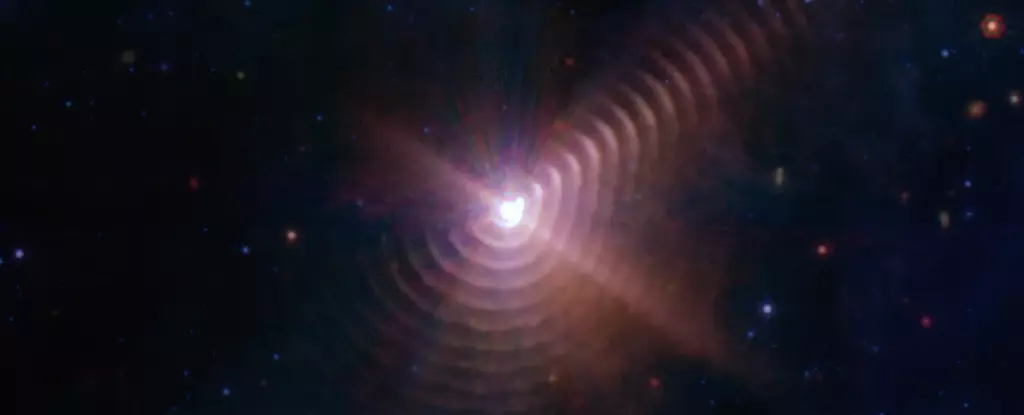Cosmic dust, often seen as an impediment in the observatory lenses of astronomers, plays a crucial role in the universe’s fabric. It is not mere space debris but rather a fundamental component for life’s emergence and the formation of terrestrial bodies like Earth. As telescopes peer into the depths of space, they grapple with this dust that blurs their vision, creating a complex interplay between observation and the reality of the universe. The advent of the James Webb Space Telescope (JWST) has promised to transcend these limitations, enabling scientists to delve into the enigmatic realm of cosmic dust—and the binary star system WR 140 is a shining example of that pursuit.
Located roughly 5,000 light-years away in the constellation Cygnus, the Wolf-Rayet binary WR 140 serves as an ideal laboratory for studying dust formation. A 2022 study published in Nature Astronomy outlined the intricate dynamics at play in this system, focusing on the remarkable periodicity of dust formation tied to the stars’ orbital movements. WR 140, composed of a Wolf-Rayet star and an OB star, engages in a cosmic ballet where their stellar winds crash together every 7.93 years. This collision produces carbon-rich dust, which then expands outward, forming discernible rings visible through advanced astronomical instruments like the JWST.
The significance of these findings is multi-faceted. The stellar environment within WR 140 is nothing short of chaotic, as the winds from the two massive stars, rich in chemistry, create conditions for dust formation during their close encounters. By observing these dust formations at intervals defined by the orbit of the stars, astronomers can explore how and why some stars contribute to cosmic dust while others do not—essentially addressing a critical gap in our understanding of the universe.
The Photographic Evidence: JWST’s Revelations
In 2022, the JWST unveiled the initial images of this fascinating system, capturing the dust rings that had formed since the last periastron passage in 2016. The startling clarity and detail offered by JWST allowed for the first real-time tracking of these cosmic phenomena. Just over a year later, further observations demonstrated noticeable changes to the concentric rings of dust, showcasing their consistent expansion and revealing dynamics not previously captured at such short intervals. Emma Lieb, the lead author of the follow-up study, expressed the excitement within the scientific community at viewing noticeable changes in a time frame that defies typical astronomical expectations.
The observations made by the JWST are exceptional; they highlight a paradigm shift in astrophysical research. Traditional astronomy often involves studying events that unfold over millions or billions of years, whereas the data from WR 140 presents a refreshing view of astronomical change occurring on a notably human timescale.
While other carbon-rich Wolf-Rayet binaries produce dust, WR 140 surpasses them in terms of activity and periodicity. Most of these systems either have wider orbital separations or lack the energetic interactions observed in WR 140. The remarkable output of dust from WR 140 defines it as an outlier, emphasizing the importance of investigating such systems for insights into how dust contributes to the larger cosmic landscape.
The JWST’s imaging capabilities have enabled researchers to not only observe existing dust but also consider its potential role in creating organic materials and influencing star formation. The dust produced by WR 140 could serve as the seed material for new stars and planetary systems, embarking on a cosmic cycle that stretches across epochs.
Observations of WR 140 provide tantalizing hints at the mechanics behind dust production, as well as its ultimate fate in the cosmic environment. Scientists speculate that the formation of carbon-rich dust shells will continue for extensive periods, up to several hundred thousand years. Using the JWST, researchers have the opportunity to document this process in nearly real-time, offering unprecedented insight into the interactions between massive stars before they end their lives—potentially as supernovae or black holes.
Ultimately, the revelations from the JWST will broaden our understanding of cosmic dust’s role in the universe. As humanity directly benefits from the knowledge garnered from systems like WR 140, it invites a deeper inquiry into the origins of the materials that compose our very existence.
The landscape of astrophysics is undergoing a transformation, thanks in large part to the revelations from advanced tools like the JWST. By tearing through the obscuring veil of cosmic dust, scientists have been able to peer into dynamic systems like WR 140 and extract knowledge about the intricate processes of our universe. As we look to the future, the ongoing studies of these stellar phenomena promise to illuminate the pathways by which dust contributes to the cradle of life and the formation of planetary systems, echoing across the vast fabric of space and time.


Leave a Reply